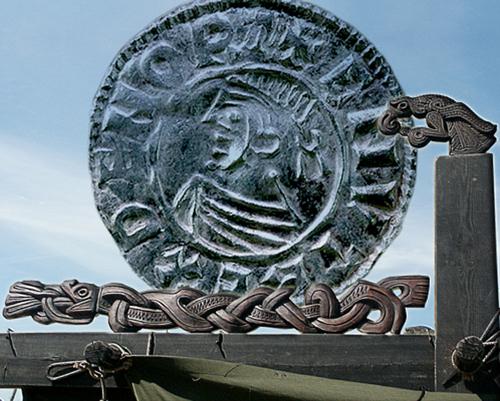| Handelspladserne

| | I løbet af vikingetiden dukker der en speciel type af handelspladser op, de såkaldte -købinger i den østlige del af det danske rige. Købingerne ligger i områder, som har haft en lidt større bebyggelsesaktivitet. De kan dateres til 800-tallet og frem til 1000-tallet.
Sandsynligvis er deres betydning som internationale bygde-handelspladser forsvundet i takt med de tidlige byers fremvækst. Men der har sikkert også eksisteret andre former/typer for internationale handelspladser. |
- købingerne
Skåne var tidligere opdelt i herreder. Hvornår denne opdeling i herreder har fundet sted, er ikke helt klarlagt Første gang, ordet ”herred” nævnes, er i ærkebiskop Eskilds tid, 1138-1177 og drejer sig om Skytts herred i den sydvestlige del af Skåne. Sammenligner man imidlertid herredsgrænserne med kortet, der viser koncentrationen af kirker i den tidlige middelalder, kan man ane, at herrederne er blevet oprettet ud fra de ældgamle centralområder. Sandsynligvis er herredsgrænserne fastlagt for at den kongelige administration kunne få et redskab til at overskue befolkningssammensætningen.
Hver centralområde ,som ligger ved kysten, har haft et såkaldt ”købing”- sted . Disse købinger anses for at være forløbere for den sene vikingetids byer. Vi finder dem alle nær den skånske kyst i forbindelse med vandløb, hvorfor de må have været centralområdernes internationale handelspladser. Kortet viser beliggenheden. Syd for Helsingborg ved Rååen ligger Køpinge, som i dag er helt udbygget. Ved Løddeå ligger Løddekopinge, ved Pilebækken syd for Malmø: Høkøpinge og ved Dalkøpingsåen øst for Trelleborg: Dalkøpinge. Øst for Ystad ligger Store Køpinge ved Nybroåen og syd for Kristianstad finder man Gærds Køpinge ved Helgeå.
Køpinge egnene ligger alle ved vandløb, som har direkte forbindelse til havet. Hvilken betydning har disse vandløb haft for handelspladsernes opståen? De store åer, Rååen, Løddeå og Helgeå har gjort det muligt for vikingeskibe at komme fra kysten og ind i landet. De øvrige handelspladser ligger derimod ved vandløb, som man i dag nærmest ville betegne som større bække. Af disse ligger Høkøpinge ved Pilebæcken og Stora Køpinge ved Nybroåen, forholdsvis langt inde i landet. Disse vandløb har ikke været farbare for handelsskibe.
Ved Høkøpinge findes der helt ude ved kysten resten af et forsvarsanlæg i form af en dobbelt, oval voldgrav med rester af volde. Der må antagelig have været en slags udkigspost ved denne landingsplads, måske en kontrolpost for anduvende handelsskibe.

Kirketæthed i Skåne |
Løddekøpinge
Løddekøpinge er det arkæologisk mest udgravede ”køpinge”- sted i Skåne. Allerede i 1960erne påbegyndtes udgravningerne her. Da man gravede de øvre jordlag væk for at forberede opførelsen af et antal villaer, blotlagdes nogle store, sorte firkanter i det lyse sand. Disse firkanter var rester af mindre nedgravede huse fra vikingetiden, såkaldte grubehuse. Husene har været temmelig primitive og antallet af huse tyder på, at der her har ligget en markedsplads. Området ligger godt 2 km. oppe af den brede Løddeå.
Grubehusenes størrelse har varieret fra 6 til 20 kvadratmeter. Sandlag i husenes gulve viser, at bygningerne i perioder har stået forladte, hvilket bestyrker antagelsen om, at der er tale om en markedsplads, som er blevet brugt på bestemte årstider. Husene stammer fra 700-tallet frem til omkring år 900. På den tid synes markedspladsen at være flyttet yderligere en kilometer længere op ad åen. På denne senere boplads ligger der ret store huse, som arkæologerne har tolket som en mere permanent bebyggelse. Her findes også den ældste, kristne kirkebygning med en meget stor kirkegård. Selv om hele kirkegården ikke er udgravet, er der fundet 1412 grave fra vikingetiden. Rester af to trækirker fra slutningen af 900-tallet – 1000-tallet er udgravet midt på kirkegården. Møntfund i gravene viser, at de yngste grave senest stammer fra Oluf Hungers tid, dvs. 1086-1095.
Se skitse over kirkegården.

Vikingegrave |
Halør
Længst nede i det sydvestlige hjørne af Skåne ligger Høllviken. Navnet kan måske tolkes som ”vigen ved den store ”høllen” ” dvs. ved den store hal. Strandengene mellem Høllviken og Foteviken kaldtes i 1500-tallet ”Lille Vies ager”. Et ”Vi” betegner et helligt, hedensk sted; et tempel eller en hellig lund. I dette ”Vi”-område har Fotevikens Museum udgravet en skibsgrav fra vikingetiden, hvilket støtter teorien om, at det drejer sig om et helligt sted. Til et sådant sted for afgudsdyrkelse hørte altid en eller flere store haller, hvor der blev holdt offerfester. Høllviken kan altså udlægges som navnet på vigen ved den store hal ved det hellige sted.
Dette område mellem Høllviken og Foteviken kaldtes sandsynligvis Halør. Se kapitlet ”Om ”ør”-ne i sundet”. Her lå der i vikingetiden en meget stor markedsplads. I ”Færingesagaen,” som blev nedskrevet før år 1100, berettes om en episode fra slutningen af 900- tallet : ”Der (dvs. i Halør) havde en stor skare samlet sig, og det siges, at medens markedet holdes, er der ingen steder i hele Norden, hvor så mange mennesker mødes.”
Markedet ved Halør har sandsynligvis været af en anden type end købingstedernes markeder. På købingstederne har folk fra forskellige områder handlet med hinanden. I Halør har handelsmænd fra forskellige lande mødtes og handlet. Dette sted i det sydvestlige Skåne er velegnet til en sådan handelsplads. Den fremskudte Falsterbohalvø bliver en naturlig grænsezone for søfarende handelsfolk fra øst og vest. Markedet ved Halør blev holdt hvert år i begyndelsen af sommeren.
Man må skelne mellem Halørmarkedet og det sildemarked, som opstod i Skanør på den anden side af Høllviken omkring år 1200. Skanørmarkedet blev holdt i august-september, den tid, hvor silden viste sig i store mængder i Øresund. Skanørmarkedet var desuden et fiskemarked og som sådant krævede det enorme mængder salt importeret fra Tyskland. Da Halørmarkedet eksisterede var salt imidlertid en meget kostbar vare, som kun fandtes i små mængder. Halørmarkedet kan således ikke have været et fiskemarked.

Halör |
|